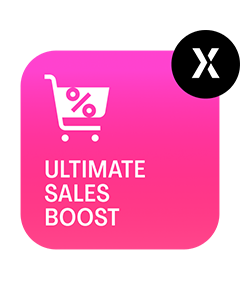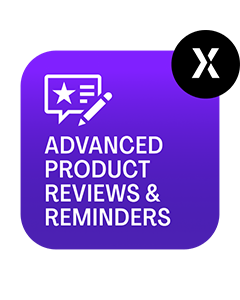-
![]()
Advanced Product Options Suite
A feature-rich and highly customizable solution to set and manage Magento product options. Display your product variations beautifully and accurately. -
![]()
SEO Suite Ultimate
The pioneer Magento SEO extension, instantly enhanced and updated to comply with the continuous changes in the SEO world. All-in-one Adobe Commerce SEO toolkit. -
![]()
Shipping Suite
All you could possibly need to build a Magento shipping system. Shipping methods, rates, carriers, shipping cost calculator, zip code validation. -
![]()
Ultimate Sales Boost
Need to give your Magento store an ultimate sales boost? Build urgency, scarcity, and trust with the help of countdown timers, products popularity popups, stock status, etc. -
![]()
Order Management
Magento delete orders functionality. Editing any order details without having to cancel orders. Adding 28 extra order parameters and 20 extra order mass actions. Staff access levels. -
![]()
Store Locator & In-Store Pickup
Magento 2 Store Locator extension to introduce BOPIS. No-contact delivery. Curbside pickup. Items’ availability tracking. Store locations on Google Maps. -
![]()
Checkout Suite
Magento One Page Checkout extension to introduce a delivery-oriented checkout flow. Comes with integrated Delivery Date and Store Locator & In-Store Pickup. -
![]()
Delivery Date & Time
All you need to display estimated shipment dates in your Magento-based store. Checkout page delivery. Shipping date restrictions and extra charges for specific time slots. -
![]()
Customer Prices Suite
The toolkit to personalize Magento prices and discounts. Shopper- and group-specific customer prices. Individual and group promotions. Updating prices in bulk.
-
![]()
Shipping Suite
All you could possibly need to build a Magento shipping system. Shipping methods, rates, carriers, shipping cost calculator, zip code validation. -
![]()
SEO Suite Ultimate
The pioneer Magento SEO extension, instantly enhanced and updated to comply with the continuous changes in the SEO world. All-in-one Adobe Commerce SEO toolkit. -
![]()
Advanced Product Options Suite
A feature-rich and highly customizable solution to set and manage Magento product options. Display your product variations beautifully and accurately. -
![]()
Gift Cards
Online and offline Magento 2 gift card giving made easy. Flexible pricing schemes, multi-store gift cards, flexible pricing configuration possibilities. -
![]()
Multi Fees
Magento 2 extra fee extension that allows you to set up any Magento fee, including product, shopping cart, shipping methods, license, handling, and transaction fees. -
![]()
Reward Points
Build a Magento 2 reward points program that works! Reward your most active and loyal customers, motivate hesitating ones and generate more profit for each order. -
![]()
Store Locator & In-Store Pickup
Magento 2 Store Locator extension to introduce BOPIS. No-contact delivery. Curbside pickup. Items’ availability tracking. Store locations on Google Maps. -
![]()
Delivery Date & Time
All you need to display estimated shipment dates in your Magento-based store. Checkout page delivery. Shipping date restrictions and extra charges for specific time slots. -
![]()
File Downloads and Product Attachments
Add any kind and any format of Magento 2 product attachments to your product pages―equip them with product videos, user guides, price lists, etc.
-
![]()
Gift Cards
Online and offline Magento 2 gift card giving made easy. Flexible pricing schemes, multi-store gift cards, flexible pricing configuration possibilities. -
![]()
Multi Fees
Magento 2 extra fee extension that allows you to set up any Magento fee, including product, shopping cart, shipping methods, license, handling, and transaction fees. -
![]()
Reward Points
Build a Magento 2 reward points program that works! Reward your most active and loyal customers, motivate hesitating ones and generate more profit for each order. -
![]()
Shipping Suite
All you could possibly need to build a Magento shipping system. Shipping methods, rates, carriers, shipping cost calculator, zip code validation. -
![]()
Advanced Product Options Suite
A feature-rich and highly customizable solution to set and manage Magento product options. Display your product variations beautifully and accurately. -
![]()
SEO Suite Ultimate
The pioneer Magento SEO extension, instantly enhanced and updated to comply with the continuous changes in the SEO world. All-in-one Adobe Commerce SEO toolkit.
-
![]()
SEO Suite Ultimate
The pioneer Magento SEO extension, instantly enhanced and updated to comply with the continuous changes in the SEO world. All-in-one Adobe Commerce SEO toolkit. -
![]()
Advanced Product Reviews & Reminders
Use Magento 2 Review Reminder to increase trust in your brand by transforming Magento 2 reviews into advanced product feedback. Trigger email/popup review reminders.
-
![]()
SEO Suite Ultimate
The pioneer Magento SEO extension, instantly enhanced and updated to comply with the continuous changes in the SEO world. All-in-one Adobe Commerce SEO toolkit. -
![]()
Landing Pages
The Landing Pages Magento extension allows you to create SEO- and user-friendly landing pages for your marketing campaigns. Pages creation in bulk. -
![]()
Layered Navigation
A set of flexible features to make Magento layered navigation search engine and user-friendly. Advanced configuration of filter attributes. -
![]()
Extended Rich Snippets
Draw users' attention and win the click with more detailed Magento rich snippets. Developed according to the latest Google and Schema.org standards. -
![]()
SEO Meta Templates
The Magento 2 SEO Meta Tags Template module to optimize product and category page metadata, keywords, short and detailed descriptions. -
![]()
Cross Linking
All you need to create and manage Magento 2 cross-linking SEO. Internal links optimization on the product, category, and CMS pages. Linking to relevant external sources. -
![]()
Sitemap Suite
XML and HTML Magento 2 sitemaps to enhance your site’s crawling, indexation, and navigation. Magento 2 Cron for automatic sitemaps navigation. -
![]()
Short Category & Product URLs
Make product and category pages better crawled by the search engine spiders. Use the Magento Short URL extension to remove parent categories from URLs.
-
![]()
Shipping Suite
All you could possibly need to build a Magento shipping system. Shipping methods, rates, carriers, shipping cost calculator, zip code validation. -
![]()
Store Locator & In-Store Pickup
Magento 2 Store Locator extension to introduce BOPIS. No-contact delivery. Curbside pickup. Items’ availability tracking. Store locations on Google Maps. -
![]()
Delivery Date & Time
All you need to display estimated shipment dates in your Magento-based store. Checkout page delivery. Shipping date restrictions and extra charges for specific time slots. -
![]()
Shipping Table Rates
With our Magento 2 Shipping Table Rates extension, you can overcome the default limitations and create an unlimited number of carriers, methods, and shipping rates. -
![]()
Shipping Calculator on Product Page
Increase conversion rates and improve customer experience by letting your shoppers calculate the cost of shipping right on your product pages. Estimated shipping block. -
![]()
Green Delivery
This Green Delivery module helps quickly offer such an option in your Magento-based store. Multi-store and multi-language support. -
![]()
No-Contact Delivery / Curbside Pickup
This Free Curbside Pickup module helps quickly offer the no-contact delivery option in your Magento-based store. Multi-store and multi-language support.
-
![]()
Marketing & Sales Suite
There’s no better tool to tackle Magento 2 marketing automation than this suite. Rewards program, recent sales notifications, countdown timers, review reminders, discounts. -
![]()
Customer Prices Suite
The toolkit to personalize Magento prices and discounts. Shopper- and group-specific customer prices. Individual and group promotions. Updating prices in bulk. -
![]()
Gift Cards
Online and offline Magento 2 gift card giving made easy. Flexible pricing schemes, multi-store gift cards, flexible pricing configuration possibilities. -
![]()
Reward Points
Build a Magento 2 reward points program that works! Reward your most active and loyal customers, motivate hesitating ones and generate more profit for each order. -
![]()
Multi Fees
Magento 2 extra fee extension that allows you to set up any Magento fee, including product, shopping cart, shipping methods, license, handling, and transaction fees. -
![]()
Ultimate Sales Boost
Need to give your Magento store an ultimate sales boost? Build urgency, scarcity, and trust with the help of countdown timers, products popularity popups, stock status, etc. -
![]()
Advanced Product Reviews & Reminders
Use Magento 2 Review Reminder to increase trust in your brand by transforming Magento 2 reviews into advanced product feedback. Trigger email/popup review reminders. -
![]()
Product Countdown Timers
Magento 2 Countdown Timer extension to add beautifully visualized timers to your product pages. The module comes with 20+ highly customizable design templates. -
![]()
Affiliate
Magento 2 Affiliate module helps you launch, run and manage flexible affiliate marketing programs. It allows you to effectively market your products with a low budget, low effort, and time while enjoying high ROI.
-
![]()
Advanced Product Options Suite
A feature-rich and highly customizable solution to set and manage Magento product options. Display your product variations beautifully and accurately. -
![]()
File Downloads and Product Attachments
Add any kind and any format of Magento 2 product attachments to your product pages―equip them with product videos, user guides, price lists, etc. -
![]()
Customer Prices Suite
The toolkit to personalize Magento prices and discounts. Shopper- and group-specific customer prices. Individual and group promotions. Updating prices in bulk. -
![]()
Customer Group Prices
Diversify your pricing strategy with custom Magento customer group prices. Set custom prices for wholesale and retail shoppers. Special deals for targeted groups. -
![]()
Prices per Customer
Add a personalized touch to your Magento pricing with the help of this Magento Price per Customer module. Mass update customer prices. Prices import/export. -
![]()
Product Custom Options Templates
Ease the pain of manual Magento custom options configuration. Create any number of custom options templates like color, size, dimensions, etc., in a few clicks. -
![]()
Shipping Calculator on Product Page
Increase conversion rates and improve customer experience by letting your shoppers calculate the cost of shipping right on your product pages. Estimated shipping block. -
![]()
Event Management by Staylime
Create, manage and sell Magento events. Let shoppers search for, wishlist, review any type of events as Magento products: conferences, concerts, parties, etc.
-
![]()
Order Management
Magento delete orders functionality. Editing any order details without having to cancel orders. Adding 28 extra order parameters and 20 extra order mass actions. Staff access levels. -
![]()
Order Editor
Magento edit order without canceling. Add, delete, and remove any order details, order customers' billing, payment, and shipping info. Order edit logs and staff permissions. -
![]()
Extended Orders Grid
Extend and customize the default Magento 2 orders grid. Easily add 28 extra colums with essential order parameters, perform order mass-actions, synch order data and more. -
![]()
Custom Order Number
Expand the native numbering scheme with the Magento 2 Custom Order Number module. Edit order length, add custom prefixes, increment prefixes, etc.
-
![]()
Affiliate
Magento 2 Affiliate module helps you launch, run and manage flexible affiliate marketing programs. It allows you to effectively market your products with a low budget, low effort, and time while enjoying high ROI. -
![]()
Custom Order Number
Expand the native numbering scheme with the Magento 2 Custom Order Number module. Edit order length, add custom prefixes, increment prefixes, etc. -
![]()
Shop by Brand
Brands create desire, a sense of belonging, status, and prestige. Use Magento Shop by Brand to bridge the distance between your customers and their favorite offerings. -
![]()
Short Category & Product URLs
Make product and category pages better crawled by the search engine spiders. Use the Magento Short URL extension to remove parent categories from URLs. -
![]()
Personal Customer Discount
Motivate shoppers to complete a purchase with custom-tailored coupon codes & Magento discount per customer. Select customers for promotions. -
![]()
Landing Pages
The Landing Pages Magento extension allows you to create SEO- and user-friendly landing pages for your marketing campaigns. Pages creation in bulk. -
![]()
Checkout Suite
Magento One Page Checkout extension to introduce a delivery-oriented checkout flow. Comes with integrated Delivery Date and Store Locator & In-Store Pickup. -
![]()
Layered Navigation
A set of flexible features to make Magento layered navigation search engine and user-friendly. Advanced configuration of filter attributes. -
![]()
Search Autocomplete FREE
Immediate product Magento autocomplete search results. Let your customers instantly find what they are looking for. Customizable AJAX popup.
-
![]()
Magento development
Full-cycle Magento 2 development taken care of. -
![]()
Magento migration
End-to-end migration from Magento 1 to Magento 2. -
![]()
Shopify development
Full-fledged Shopify store implementation. -
![]()
Magento maintenance & support
Ad hoc support and ongoing maintenance services for your store. -
![]()
Magento design
Unique Magento theme design and development. -
![]()
SEO Suite Ultimate configuration
Advanced configuration of our best-selling SEO extension.
Magento 2 Wiki
Marketing
Magento Marketing Tools

This section of Wiki explains how to leverage Magento marketing and marketing automation possibilities of the platform. You will learn how to tweak the out-of-the-box functionality and what third-party extensions can drastically help you expand the default limitations. We’ll focus on covering the means to make the best use of the marketing mix, i.e., cover the four Ps:
- Product
- Price
- Place
- Promotion
Let’s dig deeper into what marketing tools default Magento 2 offers.
Before you begin:
Log in to your admin panel.
In the left pane, open the Magento 2 Marketing tab.
Please note that the functionality available in Magento 2 Community (Open Source) and Magento Commerce Editions (now Adobe Commerce) differs. Naturally, the Commerce Edition has more advanced features. Compare the images below to investigate.

Source: Magento 2 Open Source admin panel

Source: Adobe Commerce admin panel
This section of Wiki covers the Community Edition features only. Thus, no Magento affiliate marketing or advanced email marketing Magento 2 functionality will be described here. However, we’ll do our best to cover such features in other posts of this marketing category.
Promotions
The Promotions section is the Magento eCommerce marketing tool, which enables you to set up catalog and price rules that trigger discounts following specified conditions.
Correspondingly, the setup is subdivided into two sections:
Catalog Price Rules
Here, attribute sets in your catalog are used to build conditions and rules that trigger discounts application as a part of your digital marketing campaigns. The configuration can remind you of assembling a statement.
For example:
If...ALL...of these conditions are...TRUE:
Product Attribute
SALE...IS…(ATTRIBUTE)
Cart Price Rules
Here, any category that is a child of the store’s root is used to build conditions and rules to trigger discounts application. These rules use either attributes or attribute combinations.
For example:
If...ALL...of these conditions are...TRUE:
Cart Attribute
TOTAL WEIGHT...IS…(AMOUNT)
Communications
Ready to launch your Magento 2 eCommerce site? Make sure to review all the channels you intend to use to communicate with your site visitors and buyers.
In this default Magento marketing section to manage communications, four tools are available. They are as follows:
Email Templates
Here, store admins get to set up and customize notifications that will be sent from your store as soon as a trigger fires.
Magento Open Source users can configure various responsive transactional emails only within the default email marketing Magento 2 possibilities.
However, to cover other email types and events (for example, emails to collect customer reviews), you’ll need to upgrade to Adobe Commerce or opt for a third-party solution. Product Review & Reminders by Mageworx lets you collect customer feedback with the help of emails, for example.
Click here to explore step-by-step guidelines on sending emails and newsletters in Magento 2.
Newsletter Templates
Newsletters are found effective in communicating with the customers.
Magento 2 Open Source allows you to create and send regular newsletter emails following an eCommerce business-specific purpose: an update, monthly or holiday news, etc. Click here for more details on the supported newsletters types.
A Magento 2 store admin can opt for the WYSIWYG editor or add and update content as HTML text.
Additionally, you will be able to edit the formatting of your template text using the CSS declarations.
Newsletter Queue
This Magento 2 marketing section allows store admins to overview newsletter lists and their statuses quickly.
Newsletter Subscribers
The best practice when doing email marketing is to review the list of your subscribers regularly.
Following your country-specific legislation, make sure to manage and complete the unsubscription requests within a specific period of time.
Conversely, the system allows you to export your subscription list via an XML or CSV file when using third-party email service providers.
Importantly:
Make sure to control any possible issues that might occur with your newsletter. For that, go to REPORTS, and then under Marketing, click Newsletter Problem Reports. The issues will be displayed here if any.
Related content:
How to Use Email Notifications for Abandoned Cart in Magento 2?
How to send emails and newsletters in Magento 2
Advertising Channels
Updated:
Following the official press release, the Google Shopping ads Channel faced the end of life on April 28, 2020, for all Adobe Commerce and Magento Open Source versions. The add-on was removed from the Commerce Marketplace, previously Magento Marketplace too.
SEO & Search
Magento Open Source offers you to fine-tune the most basic aspects of a site’s optimization for search engine crawlers. It includes the following features:
URL Rewrites
This tool allows you to edit URLs for the product, category, or CMS pages and benefit from automatic redirects that will point from an old URL to the new one.
Search Terms
This section is especially critical as it allows you to learn about search terms your customers are using to find products in the store.
With the help of such terms, not only you can learn the queries the searchers use on your site but explore products and services that might potentially be of interest to your site visitors.
Meanwhile, while considering adding new items to the catalog, why not redirect the shopper to a currently available relevant product?
Search Synonyms
Relevancy and accuracy of catalog search are gold. To ensure the effectiveness of the catalog search, store admins must list as many search terms as possible. Not to lose a sale, make sure to specify any possible terms, synonyms, and most frequent typos a shopper might make or use when searching for an item in your catalog.
Site Map
If you are looking for the means to improve how your site is indexed by the search engine crawlers, you’ll need to configure site maps.
Should you require more tools to improve the SEO of your Magento-based site, consider this extension.
Customer Engagement
The level of customer service and communication with a brand often dictate how effective the customer experience leads to a conversion or abandonment. The following cloud-based integrations can help improve Magento eCommerce marketing and let store admins advance customer engagement.
dotdigital Engagement Cloud
This built-in subscription-based integration allows you to engage with the customers via various channels and go further across emails, social media, messengers, content marketing, etc.
dotdigital Chat
Here’s another solution that is vital for an eCommerce store―chat. With its help, you can deal with customer queries quickly without forcing your shoppers to navigate away.
Exclusion Rules
If you are running dotdigital campaigns, make sure to create rules that control when abandoned shopping cart and review emails should be sent.
In this section, you can specify conditions that trigger a specific action.
For example, it can be an email exclusion rule for a specific attribute.
User Content
This section was designed to let store admins manage user-generated content in one place.
All Reviews
Here, you can overview product reviews and manage their statuses by clicking the Edit link to the left.
To better interact with the customer feedback and offer advanced product reviews functionality, consider the Product Reviews & Reminders extension.
Pending Reviews
Any submitted by a customer product review must get approved to be displayed on a site’s storefront. After a store admin ensures the submitted content is appropriate for public display, they approve or reject such reviews.
Meanwhile, all new reviews get automatically assigned the pending status until assigned an updated status.
These tools allow merchants to kickstart an effective eCommerce market strategy and increase sales.
Ecommerce Marketing Strategy
Wish to learn more about Magento affiliate marketing or some other eCommerce marketing strategy you could benefit from? Looking for the new means to meet customer expectations?
Consult other Wiki articles for more details and explore solutions available on the Magento market that help expand the default codebase of the platform significantly.
FAQ: Magento 2 Marketing
Now that Magento is an Adobe company, multiple improvements, including marketing automation, are on the way.
Out-of-the-box, the basic features only are yet available. You’ll need to opt for a third-party marketing solution to add features that you are currently missing.
The Magento Community offers a pool of options that let you enhance a required aspect of your marketing strategy.
As a first step, you can overview the following Magento marketing extensions to be aware of the type of available solutions.
Each extension available in the Magento Community brings its unique set of features. Some of the digital marketing extensions include:














































